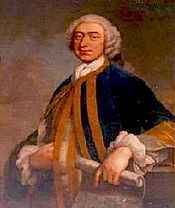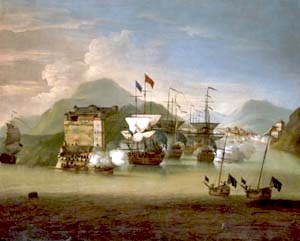Ancestry
Although there are suggestions that Juin Durel, a slater who worked on the castle around 1530, was not a Frenchman but the descendant of a line of Durels stretching back in Jersey to at least 1272, this link has not been proved. Payne's Armorial of Jersey shows Philip Durell's ancestors as being members of the Le Vavasseur dit Durell family, but this assertion has been discredited by subsequent research.
Most researchers agree that Philip was the second son of Jean Durell, who was Jersey's Solicitor-General from 1701 to 1726, and his wife Elizabeth Corbet, although some family trees show three other brothers as being older, rather than younger, than Philip. Philip had a distinguished naval officer uncle, Thomas Durell and his younger brothers George Charles Durell and another Thomas Durell, were both Royal Navy Captains, as was his nephew, Thomas's son, Thomas Philip Durell
Early life
Philip was educated by his father's sister, Madelaine Durell, the widow of Bailiff Sir Edouard de Carteret. Philip was very fond of his aunt and his will included a bequest of £300 for "a handsome monument to be erected in the church where she is interred with a due epitaph enumerating her exemplary virtues and life".
Although most historians seem to agree that Philip joined the Royal Navy as a midshipman in 1720, at the age of 13, serving on HMS Seahorse, commanded by his uncle, Captain Thomas Durell, on his first voyage carrying the newly appointed Governor to New York, there are also suggestions that he served on HMS Ludlow Castle the following year as an able seaman, which seems an unlikely step down for a midshipman.
He was promoted to Lieutenant in 1731 and married his first cousin, Madelaine de Sausmarez, of the famous Guernsey family, in 1736. Three years later he was on one of the ships led by Admiral Vernon in the capture of Porto Bello in Panama, and produced a plan of the area, his first recorded venture into mapmaking, which was published in 1740.
First commands
In 1741 he was appointed Captain of the fireship Success, and the following year, captain of another fireship, Strombolo. Later in 1742, having been promoted to Post-Captain, he commanded the frigate Gibraltar in the second battle of Finisterre. A year later he was Captain of HMS Eltham, part of Admiral Knowles's fleet which attacked Puerto Cabello in Venezuela. Durell's vessel was badly damaged and he ran out of ammunition and had to withdraw from battle.
His ship repaired, he took part in the successful attack on Louisbourg, the French fortress on Cape Breton, in 1745. Another Jerseyman, Nathaniel Messervy was Lieut-Colonel in the New Hampshire Regiment, which led the land assault. As well as creating a plan of the great harbour, which had been sheltering privateer vessels which preyed on North Atlantic shipping, Durell published A Particular Account of the Taking of Cape Breton from the French 1745. A portrait of him holding the rolled-up plan is in Sausmarez Manor in Guernsey.
In the next dozen years Durell was given a succession of commands. In June 1747, in command of HMS Chester, his squadron captured 50 French vessels; later than year he commanded HMS Gloucester and took part in Admiral Hawke's victory over the French off Finisterre. The newly launched HMS Gloucester was his next command in 1749 and in 1755 he took charge of the 74-gun HMS Terrible, which had been captured from the French in the Finisterre battle.
Battle of Minorca
Durell was next involved in a notorious battle off Minorca in 1756. He was in command of the 64-gun Trident in this drawn battle, which resulted in the English fleet's commander, Admiral John Byng, being court-martialled for cowardice in failing to pursue the superior French fleet. There had been a public outcry in England over the Navy's failure in this battle and although Byng was acquitted of cowardice he was sentenced to death (a mandatory penalty) for failing to do his utmost to defeat the French. Philip Durell gave evidence at the court martial, which recommended that King George II exercise his power of clemency to save Byng.
When he refused to do so there was a reversed public outcry in support of Byng, who was eventually shot by a marine detachment on the deck of HMS Monarque, another vessel captured along with HMS Terrible at Finisterre.
Quebec
After commanding HMS Prince George, and HMS Diana in 1758, Durell was back off Louisbourg, which had been given back to the French and now had to be recaptured. He reconnoitered the coast to find suitable landing places for troops and was rewarded by promotion to Rear-Admiral of the Blue. In February the following year he was made Rear-Admiral of the Red and was second in command of the British fleet sent to capture Quebec.
Initially things went badly for Durrell, failing to intercept a French supply convoy before it could sail up the St Lawrence, which Durell had wrongly believed to be icebound. Durell's own voyage up the river to Quebec, 1000 miles inland, was successful, howwever. It included the legitimate ruse of flying French flags to attract pilots on board, who were then forced to navigate up the river. Durell was on board the 80-gun Princess Amelia in charge of a fleet of seven other ships. On reaching Quebec he sent the Princess Amelia back to lead the rest of the fleet up the river.
After General Wolfe and the army had captured Quebec, Durell was covered in glory and promoted to Vice-Admiral of the Blue and Port Admiral of Plymouth, subsequently Commander in Chief of the Navy's American station.
Wolfe and Durell do not appear to have got on well with each other. Before the capture of Quebec, Wolfe complained to Prime Minister William Pitt about "the thorough aversion conceived by the marine of this country against navigating the river St Lawrence I will add from my own knowledge that the second naval officer in command there (Philip Durell) is vastly unequal to the weight of the business; and it is of the first importance to the country that it doth not fall into such hands". The Navy, however, supported Durell, on the grounds that sever spring ice conditions would not have allowed him to navigate the St Lawrence any earlier.
Durell died at sea on 24 August 1766 after eating dolphin, and was buried in St Paul's CHurch, Halifax, Nova Scotia, where a portrait of him hangs in the vestry.



